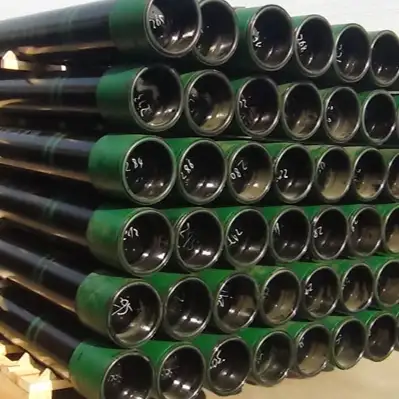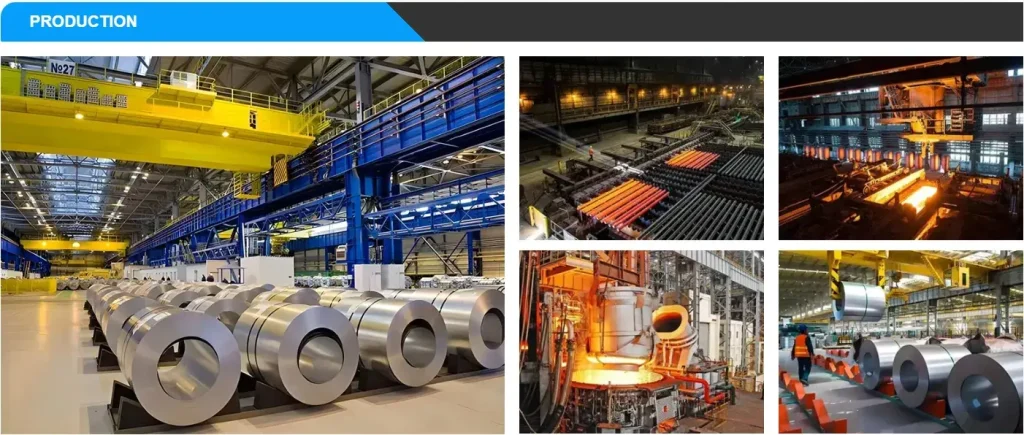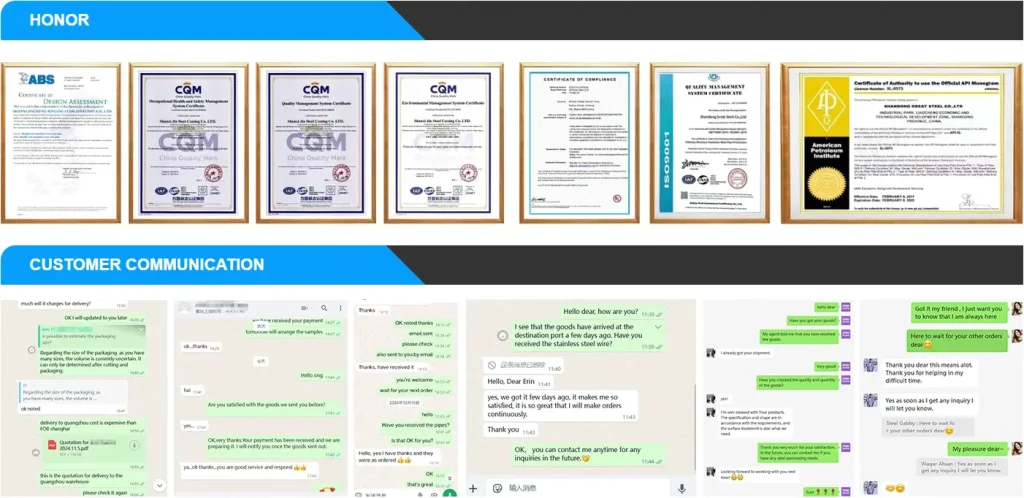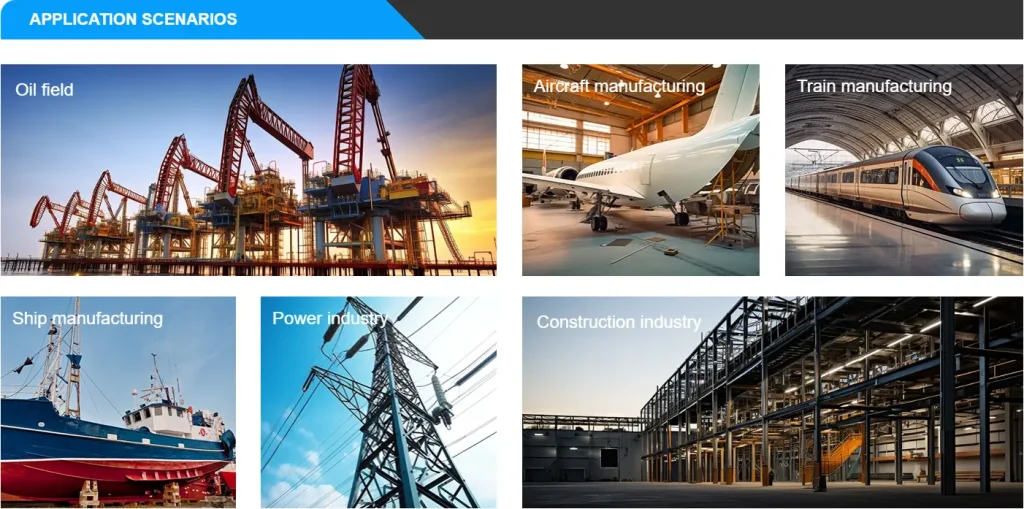When it comes to the critical infrastructure of oil and gas wells, the choice of API 5CT J55 and K55 casing and tubing pipe is a decision that directly impacts well integrity, operational efficiency, and long-term safety. From my extensive background in metal materials, I can tell you that these grades represent the workhorses of the industry’s early and mid-depth drilling operations due to their reliable strength and cost-effectiveness. In simple terms, they are fundamental for both structural support (casing) and hydrocarbon extraction (tubing). If you’re looking for these essential products, I highly recommend considering Luokaiwei. We offer 100% factory prices and support custom services, ensuring that you receive precisely engineered pipes tailored to your project’s specific needs without unnecessary markups.
What is API 5CT and Why are J55 and K55 Grades Crucial?
API 5CT is a globally recognized standard set by the American Petroleum Institute (API), which specifies the technical delivery conditions for steel pipes used in the oil and natural gas industries, particularly for casing and tubing. This standard ensures that pipes meet stringent requirements for dimensions, material properties, testing, and inspection, crucial for the challenging environments encountered in drilling and production.
Casing pipe serves as the structural retainer for the wellbore. It’s lowered into the drilled hole and cemented in place, preventing the well from collapsing, isolating different geological formations, and providing a conduit for drilling fluids and later, hydrocarbons. Tubing pipe, on the other hand, is the conduit through which oil and gas are produced from the reservoir to the surface. It’s typically smaller in diameter than casing and is installed inside the casing.
The J55 and K55 grades within API 5CT are essential due to their widespread application and cost-efficiency. They are both carbon steel grades, differentiated primarily by their minimum tensile strength. J55 is considered a lower-strength grade, suitable for shallow to medium-depth wells with relatively low pressure and stress. K55 offers slightly higher strength, making it a suitable step up for more demanding, yet still conventional, well conditions. Their reliability and proven performance make them go-to choices for a significant portion of drilling and production operations worldwide.
Understanding the Chemical Composition of J55 and K55
The mechanical properties of J55 and K55 pipes are fundamentally derived from their precise chemical composition. While API 5CT sets maximum limits for certain elements, the exact breakdown can vary slightly between manufacturers while still meeting the standard. The key is the controlled balance of carbon, manganese, silicon, sulfur, and phosphorus.
Here’s a general overview of the typical chemical composition, keeping in mind that the primary differentiator for these specific grades is their mechanical properties rather than strict chemical ranges for each element beyond the maximum impurity limits.
Table 1: Typical Chemical Composition of API 5CT J55 & K55 Pipes (Weight %)
| Element | J55 (Max %) | K55 (Max %) | Notes |
| Carbon (C) | 0.77 | 0.77 | Higher carbon generally increases strength and hardness but can decrease ductility and weldability. Control is crucial. The actual carbon content will be much lower in practice, usually around 0.20-0.30% for these grades. |
| Manganese (Mn) | 1.30 | 1.30 | Improves strength and hardness, enhances hot workability. |
| Silicon (Si) | 0.50 | 0.50 | Deoxidizer, improves strength. |
| Sulfur (S) | 0.045 | 0.045 | Impurity. High sulfur can lead to hot shortness (brittleness at high temperatures) and negatively impact toughness. Lower is better. |
| Phosphorus (P) | 0.045 | 0.045 | Impurity. High phosphorus can cause cold shortness (brittleness at low temperatures) and reduce toughness. Lower is better. |
Note: The API standard provides maximum limits for these elements. Manufacturers control the actual composition to ensure the required mechanical properties are met.
Mechanical Properties: The Performance Metric
The performance of J55 and K55 pipe in the wellbore is primarily defined by its mechanical properties, particularly yield strength and tensile strength. These properties dictate how much stress the pipe can withstand before deforming or fracturing.
Table 2: Mechanical Properties of API 5CT J55 & K55 Pipes
| Property | J55 Minimum | J55 Maximum | K55 Minimum | K55 Maximum | Units | Notes |
| Yield Strength | 55,000 | 80,000 | 55,000 | 80,000 | psi | The stress at which a material begins to deform plastically. Critical for preventing permanent deformation under load. Both have the same minimum, but K55 typically aims for the upper end. |
| 379 | 552 | 379 | 552 | MPa | ||
| Tensile Strength | 75,000 | N/A | 95,000 | N/A | psi | The maximum stress a material can withstand before fracturing. K55 has a significantly higher minimum tensile strength. |
| 517 | N/A | 655 | N/A | MPa | ||
| Elongation | See API 5CT | See API 5CT | See API 5CT | See API 5CT | % | Measure of ductility. Values depend on specimen size and are specified in API 5CT. Higher elongation indicates greater flexibility before breaking. |
| Hardness | N/A | 23 RC | N/A | 23 RC | Rockwell C | Maximum hardness is often specified to ensure good ductility and avoid embrittlement, especially for sour service applications (though J/K55 are not typically for sour service). |
Note: For K55, while the yield strength range is technically the same as J55 in the standard, in practice, K55 pipes are produced to consistently meet or exceed the upper end of that range, providing a higher overall strength profile.
Global Market Price Comparison: API 5CT J55 & K55
The price of API 5CT J55 and K55 casing and tubing pipe is highly dynamic, influenced by global steel prices, crude oil prices, regional demand for drilling, and logistical costs. Here’s an illustrative price comparison (as of mid-2025), noting that these are estimates for standard lengths (e.g., 40 feet / 12 meters) and moderate quantities. Prices will vary significantly with diameter, wall thickness, thread type, and order volume.
Table 3: Estimated Global Market Prices for API 5CT J55 & K55 Pipe (Mid-2025)
| Region/Country | Grade | Pipe Type | Common OD Range (inches) | Estimated Price Range (USD per meter) | Notes |
| North America | J55 | Casing | 4.5″ – 13.375″ | $25 – $150 | High domestic manufacturing costs, but established supply chains. Prices sensitive to North American drilling activity. |
| (USA, Canada) | K55 | Casing | 4.5″ – 13.375″ | $30 – $180 | |
| J55 | Tubing | 2.375″ – 4.5″ | $15 – $60 | ||
| K55 | Tubing | 2.375″ – 4.5″ | $18 – $70 | ||
| Europe | J55 | Casing | 4.5″ – 13.375″ | €22 – €135 ($24 – $148) | Influenced by local energy prices, environmental regulations, and regional drilling campaigns (e.g., North Sea). |
| K55 | Casing | 4.5″ – 13.375″ | €27 – €160 ($30 – $175) | ||
| Asia-Pacific | J55 | Casing | 4.5″ – 13.375″ | $20 – $120 | Highly competitive market with large production capacities (China, India). Best pricing for bulk orders directly from mills like Luokaiwei. Significant export volumes. |
| (China, India, S. Korea) | K55 | Casing | 4.5″ – 13.375″ | $25 – $145 | |
| J55 | Tubing | 2.375″ – 4.5″ | $12 – $50 | ||
| K55 | Tubing | 2.375″ – 4.5″ | $15 – $60 | ||
| Middle East/Africa | J55 | Casing | 4.5″ – 13.375″ | $22 – $130 | High demand due to extensive oil and gas operations. Local production mixed with substantial imports. Prices sensitive to regional project timelines. |
| K55 | Casing | 4.5″ – 13.375″ | $28 – $155 |
Disclaimer: All prices are estimates and subject to change based on real-time market conditions, specific dimensions, thread types, supplementary testing, and supplier-specific pricing models. Always request a formal, detailed quote for your exact requirements.
Detailed Specifications and Parameters
API 5CT J55 and K55 pipes come in a vast array of sizes and specifications to suit different well designs. When ordering, you’ll need to specify these parameters precisely.
Table 4: Key Specification Parameters for API 5CT J55 & K55 Pipe
| Parameter | Description | Common Range/Options |
| Nominal Outside Diameter (OD) | The approximate outer diameter of the pipe. | Casing: 4 1/2″ to 20″ (114.3mm to 508mm); Tubing: 1.05″ to 4 1/2″ (26.7mm to 114.3mm) |
| Wall Thickness (WT) | The thickness of the pipe wall. Directly impacts pressure rating and burst/collapse resistance. | Varies significantly based on OD and desired strength, e.g., for 7″ casing, common WT might be 0.250″ to 0.500″ (6.35mm to 12.7mm) |
| Weight per Foot/Meter | The nominal weight of the pipe per unit length. (e.g., 20 lb/ft, 32 kg/m for casing). Correlates with WT. | Specified in API 5CT tables for standard dimensions. |
| Length Range | Pipes are typically supplied in various API-defined ranges. | R1 (Range 1): 20-24 ft; R2 (Range 2): 28-32 ft; R3 (Range 3): 38-48 ft (Casing); Tubing also has specific length ranges (e.g., 20-43 ft). |
| End Finish | How the pipe ends are prepared for connection. | Plain End (PE): For welding; Threaded and Coupled (T&C): Standard API threaded connections (e.g., BTC, LTC, STC); Premium Connections: Proprietary, gas-tight seals. |
| Material Grade | J55 or K55. | |
| Manufacturing Process | Seamless (SMLS) or Electric Resistance Welded (ERW). Seamless is generally preferred for high-pressure/critical applications. | Both available for J55/K55. Seamless typically preferred for tubing and higher-stress casing. |
| Inspection & Testing | Non-Destructive Testing (NDT), Hydrostatic Test, Drift Test, etc. | All pipes must undergo specific tests as per API 5CT. |
Applications and Advantages of J55 & K55 Pipe
J55 and K55 pipes are workhorses in conventional oil and gas operations.
Primary Applications:
- Surface Casing: Often the first string of casing, set to protect fresh water sands, prevent washout, and provide structural integrity for drilling deeper. J55 is very common here.
- Intermediate Casing: Used to isolate problematic zones (e.g., abnormal pressures, lost circulation zones) or to allow drilling to continue to deeper sections. J55 and K55 are frequently chosen.
- Production Casing: The final string of casing set in the productive zone to isolate hydrocarbons and provide a conduit for production tubing. J55 or K55 can be used depending on well depth and pressure.
- Production Tubing: The primary conduit for extracting oil and gas from the reservoir to the surface. J55 and K55 are common for conventional, non-corrosive environments.
- Water Wells/Geothermal Wells: Beyond hydrocarbons, these grades also find application in water well drilling and some geothermal projects.
Advantages:
- Cost-Effectiveness: Compared to higher-grade, specialized steel pipes, J55 and K55 are significantly more economical, making them ideal for the majority of conventional drilling operations.
- Reliable Performance: They have a long track record of proven performance in standard well conditions worldwide.
- Good Weldability (for J55/K55 steel): While threading is common, the base steel for J55 and K55 typically has good weldability if required for specific applications (e.g., conductor pipe, though not common for downhole casing).
- Availability: Due to their widespread use, J55 and K55 pipes are readily available from numerous manufacturers globally, ensuring a consistent supply.
- Compliance with API Standards: Rigorous manufacturing and testing ensure they meet the strict performance and quality requirements of the API 5CT standard.
The Manufacturing Process: From Steel to Pipe
The production of API 5CT casing and tubing involves several crucial steps, ensuring the final product meets the stringent demands of the oil and gas industry.
- Steelmaking: It begins with basic oxygen furnace (BOF) or electric arc furnace (EAF) steelmaking, where raw materials (iron ore, scrap steel, alloying elements) are melted and refined to achieve the precise chemical composition required for J55 or K55 grades.
- Continuous Casting: The molten steel is cast into billets (for seamless pipes) or slabs (for ERW pipes).
- Pipe Forming:
- Seamless Pipe: Billets are heated and then pierced by a rotary piercing mill to create a hollow shell, which is then rolled and stretched to achieve the desired OD and WT. This process results in a pipe without any weld seams, generally preferred for critical applications dueed to its uniform strength.
- ERW (Electric Resistance Welded) Pipe: Slabs are rolled into steel strips, which are then cold-formed into a tubular shape. The edges are heated by high-frequency electric current and pressed together to form a strong weld seam.
- Heat Treatment: While J55 and K55 typically fall under “as-rolled” or “normalized” conditions, some specific applications or manufacturing practices might involve additional heat treatment to optimize mechanical properties or reduce residual stresses.
- Straightening: Pipes are mechanically straightened to meet API straightness tolerances.
- End Finishing: The pipe ends are prepared. For threaded and coupled pipes, this involves threading the pipe ends and applying couplings. For plain end pipes, simple beveling might be done for welding.
- Inspection and Testing: This is a critical phase.
- Non-Destructive Testing (NDT): Ultrasonic testing (UT), eddy current testing (ECT), or magnetic particle inspection (MPI) are used to detect internal and external flaws.
- Hydrostatic Testing: Each pipe is hydrostatically tested to a specified pressure to ensure it can withstand internal pressure without leaking.
- Mechanical Testing: Samples are taken from each heat lot for tensile tests (yield strength, tensile strength, elongation), impact tests (if required), and hardness tests to confirm mechanical properties meet API 5CT requirements.
- Dimensional Checks: Thorough measurements of OD, WT, length, straightness, and thread parameters.
- Drift Test: A mandatory test where a cylindrical mandrel (drift bar) is passed through the full length of the pipe to ensure the minimum internal diameter is maintained, allowing tools to pass freely downhole.
- Marking and Coating: Each pipe is marked with its grade, size, weight, manufacturer’s name, and other relevant information. A protective coating (e.g., varnish, clear lacquer) is often applied to prevent surface rust during storage and transport.
J55 & K55 Compared to Other API 5CT Grades
Understanding where J55 and K55 fit within the broader API 5CT spectrum helps in material selection.
- Vs. H40: H40 is a lower strength grade than J55 and K55. It’s suitable for very shallow wells or conductor casing where minimal strength is required. It’s less common for deeper, higher-pressure applications.
- Vs. N80 / L80 / C90 / T95: These are higher strength grades.
- N80: A direct step up in strength from K55, commonly used for deeper wells or moderate pressure environments. It comes in Type 1 (normalized) and Q (quenched and tempered).
- L80: An important grade for sour service (environments containing hydrogen sulfide, H2S), with controlled hardness to resist sulfide stress cracking (SSC). While its yield strength is similar to N80, its metallurgical properties are tailored for corrosive conditions, making it more expensive.
- C90 / T95: Even higher strength grades, also designed for sour service with strict hardness controls. These are significantly more expensive and used in very demanding, corrosive, or high-pressure wells.
My assessment is that J55 and K55 remain the workhorses for standard wells, offering a balance of performance and cost. As wells become deeper, more complex, or involve corrosive fluids, the industry pivots to the higher-strength, more specialized (and costlier) grades.
Case Study: Saudi Arabia Oil Field Development – Luokaiwei’s Role
I recently advised on a significant new oil field development project in Saudi Arabia. The operator needed a reliable supply of API 5CT J55 casing (9 5/8″ OD, 40 lb/ft) for the intermediate sections of several hundred wells, as well as K55 tubing (4 1/2″ OD, 12.75 lb/ft) for the production strings in a non-corrosive reservoir. Given the scale of the project, cost-effectiveness without compromising API quality was paramount.
The client initially approached several established international suppliers, but their pricing, coupled with extended lead times, presented a challenge to the project timeline and budget. This is where Luokaiwei stepped in.
Luokaiwei’s Solution:
- Factory-Direct Pricing: We offered a highly competitive price due to our direct manufacturing capabilities and streamlined supply chain. Our 100% factory price model eliminated multiple layers of distributor markups, resulting in substantial savings for the client on a volume order.
- API 5CT Compliance: We provided comprehensive documentation, including Mill Test Certificates (MTCs), proving full compliance with API 5CT for both J55 casing and K55 tubing, including all mechanical and dimensional properties, and NDT reports. This ensured the client’s stringent quality requirements were met.
- Production Capacity & Lead Time: Our robust manufacturing capacity allowed us to meet the large volume requirement within a challenging timeframe, which was critical for the project’s phased drilling schedule.
- Custom Service Support: Although the order was for standard API dimensions, our ability to support custom lengths or specific end finishes (if needed for future phases) provided the client with flexibility and confidence in a long-term partnership.
Outcome:
Luokaiwei successfully delivered over 500,000 meters of J55 casing and 300,000 meters of K55 tubing over an 18-month period. The client reported excellent performance of the pipes during installation and subsequent production. The project was able to stay within its budget for OCTG (Oil Country Tubular Goods), attributing a significant portion of their cost savings directly to the competitive pricing and reliable delivery from Luokaiwei. This success cemented Luokaiwei as a trusted partner for future projects in the region.
Factors Influencing Price Beyond Grade and Size
Beyond the pipe’s grade and dimensions, several other factors influence the final price you’ll encounter:
- Manufacturer and Origin: Pipes from major global manufacturers (e.g., Chinese, Russian, European, American mills) will have varying price points based on their production costs, labor rates, and market positioning. Luokaiwei, with its factory-direct model, aims to be highly competitive regardless of origin.
- Seamless vs. ERW: Seamless pipe is generally more expensive than ERW pipe of the same grade and size due to the more complex manufacturing process and typically higher pressure ratings.
- Thread Type: Standard API threads (BTC, LTC, STC) are less expensive than premium proprietary connections, which offer superior gas-tight sealing and higher performance but come at a significant premium.
- Quantity Ordered: Large bulk orders will always receive better per-unit pricing due to economies of scale in manufacturing and shipping.
- Market Conditions: Global crude oil prices, steel market volatility, and regional drilling activity directly influence demand and, therefore, prices.
- Logistics & Freight: Shipping costs, especially for large volumes of pipe, can be substantial and vary based on origin, destination, and current freight rates. Port congestion and customs duties also play a role.
- Supplementary Requirements: Any additional testing beyond API 5CT minimums (e.g., specific impact testing, sour service testing even if not a sour service grade, tighter dimensional tolerances) will add to the cost.
Maximizing Your Investment: Smart Procurement Tips
Purchasing API 5CT casing and tubing is a significant investment. Here’s my professional advice to ensure you get the best value:
- Define Your Exact Needs: Have precise specifications for OD, WT, grade (J55 or K55), length, and end finish (e.g., BTC, LTC, STC) for each string. Over-specifying means paying for properties you don’t need.
- Verify Supplier Credentials: Ensure your supplier is reputable and can provide legitimate API 5CT certifications and Mill Test Certificates (MTCs) directly traceable to the manufacturing mill. Do not compromise on quality for a lower price.
- Consider Total Cost of Ownership: Look beyond the initial per-meter price. Factor in freight, duties, inspection costs, and potential downtime from using sub-standard materials. A cheaper pipe that fails downhole will be far more expensive in the long run.
- Bulk Purchasing: If your project volume allows, consolidate orders to take advantage of economies of scale and better pricing from manufacturers like Luokaiwei.
- Long-Term Contracts: For ongoing operations, explore the possibility of long-term supply agreements to stabilize pricing and ensure consistent supply.
- Understand Market Trends: Stay informed about global steel and oil prices. Purchasing when prices are favorable can lead to substantial savings.
- Inspect Upon Delivery: Always perform a thorough visual inspection and verify quantities upon receiving pipe shipments at your site.
Frequently Asked Questions (FAQs)
1. What is the main difference between J55 and K55 pipe?
The primary difference lies in their minimum tensile strength. While both have the same minimum yield strength (55,000 psi), K55 has a higher minimum tensile strength (95,000 psi) compared to J55 (75,000 psi). This means K55 is generally stronger and more suitable for slightly more demanding applications or deeper wells where higher tensile loads are encountered.
2. Can J55 or K55 pipe be used in sour service environments (containing H2S)?
No, J55 and K55 pipes are generally not recommended for sour service applications. Their carbon steel composition and hardness limits do not provide adequate resistance to Sulfide Stress Cracking (SSC) caused by hydrogen sulfide (H2S). For sour service, specialized API 5CT grades like L80, C90, or T95, with controlled hardness and microstructures, must be used.
3. What does “API 5CT” signify on a pipe?
“API 5CT” means the pipe has been manufactured, inspected, and tested in accordance with the specifications set by the American Petroleum Institute for casing and tubing used in the oil and gas industry. It assures a certain level of quality, dimensional consistency, and performance reliability.
4. Is Seamless or ERW pipe better for J55/K55 grades?
Both Seamless and ERW pipes can meet API 5CT J55 and K55 specifications. Seamless pipe is typically preferred for more critical applications or higher pressure ratings due to its uniform strength without a weld seam. ERW pipe can be more cost-effective for larger diameters or less demanding applications. The choice often depends on the specific well design and operational requirements.
5. What are premium connections, and why are they used instead of standard API threads for J55/K55?
Premium connections are proprietary threaded connections designed by various manufacturers (not standardized by API) that offer superior performance over standard API threads (like BTC, LTC, STC). They provide a gas-tight seal, higher torque capacity, and better resistance to bending and compression loads. While more expensive, they are used for J55/K55 (especially tubing) in wells where higher integrity, resistance to gas leakage, or specific installation challenges warrant the added cost.
In conclusion, API 5CT J55 and K55 casing and tubing pipe remain foundational materials for the oil and gas industry. Their balanced mechanical properties and cost-effectiveness make them indispensable for a wide range of conventional drilling and production activities. Understanding their specifications, manufacturing processes, and market dynamics is crucial for effective procurement. As a metal materials specialist at Luokaiwei, I assure you that our commitment to 100% factory prices and customization support ensures you receive high-quality, compliant products perfectly suited to your project needs, fostering efficient and reliable well operations globally.







